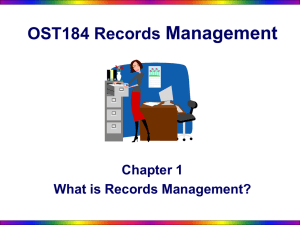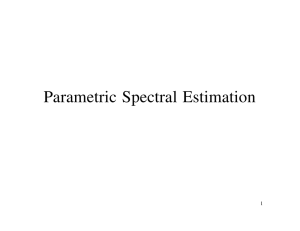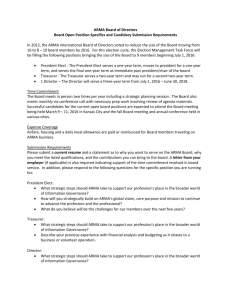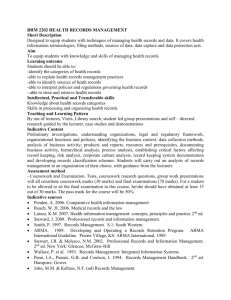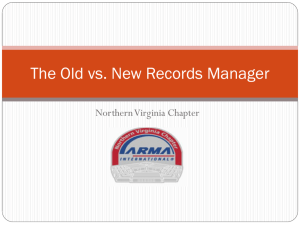- of streamflow: studies case
advertisement
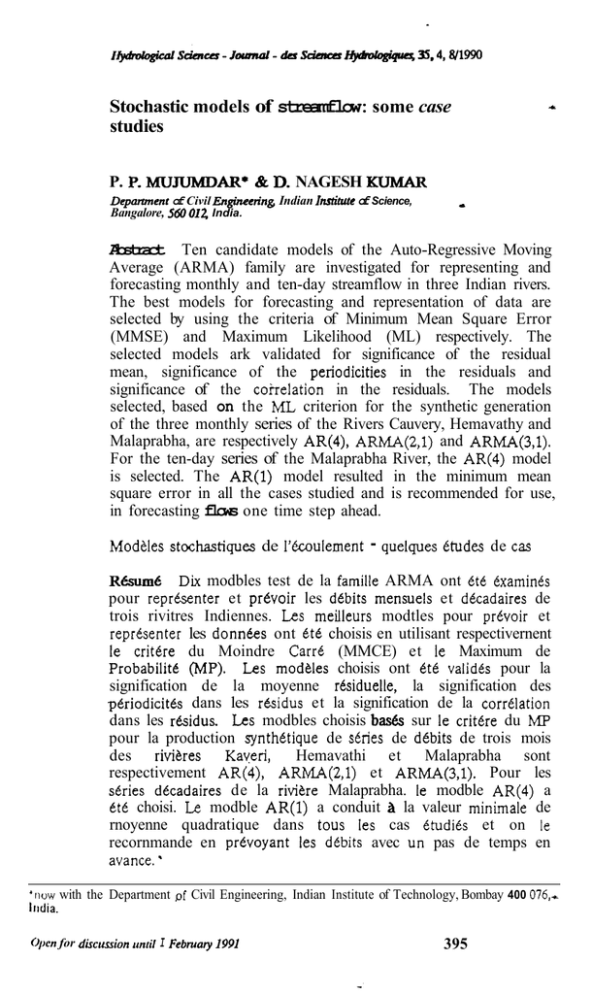
Stochastic models of streamflow: some case
studies
P. P. M U W A R * & D. NAGESH KUMAR
Depamnent of Civil En@eenn& Indian Im'hue of Science,
Bangalore, 560 012, India.
t
-
Abstract Ten candidate models of the Auto-Regressive Moving
Average (ARMA) family are investigated for representing and
forecasting monthly and ten-day streamflow in three Indian rivers.
The best models for forecasting and representation of data are
selected by using the criteria of Minimum Mean Square Error
(MMSE) and Maximum Likelihood (ML) respectively. The
selected models ark validated for significance of the residual
mean, significance of the periodicities in the residuals and
significance of the coirelation in the residuals. The models
selected, based on the ML criterion for the synthetic generation
of the three monthly series of the Rivers Cauvery, Hemavathy and
Malaprabha, are respectively AR(4), ARMA(2,l) and ARMA(3,l).
For the ten-day series of the Malaprabha River, the AR(4) model
is selected. The AR(1) model resulted in the minimum mean
square error in all the cases studied and is recommended for use,
in forecasting flows one time step ahead.
Modbles stochastiques de I'hulement
- quelques Ctudes de cas
R h m 6 Dix modbles test de la famille ARMA ont t t t txarnints
pour reprkjenter et prevoir les dtbits mensuels et dkadaires de
trois rivitres Indiennes. Les meilleurs modtles pour prbvoir et
reprtsenter les donnQs ont ttC choisis en utilisant respectivernent
le crittre du Moindre CarrC (MMCE) et le Maximum de
ProbabilitC (MP). Les modBles choisis ont t t t valid& pour la
signification de la moyenne rhiduelle, la signification des
ptriodicites dans les rhidus et la signification de la corrtlation
dans les rhidus. Les modbles choisis bas& sur le crittre du M P
pour la production synthetique de series de dtbits de trois mois
des rivibres Kaveri, Hemavathi et Malaprabha sont
respectivement AR(4). ARMA(2,l) et ARMA(3.1). Pour les
series dtcadaires de la rivibre Malaprabha. le modble AR(4) a
t t t choisi. Le modble AR(1) a conduit 3 la valeur minimale de
rnoyenne quadratique dans tous les cas ttudits et on le
recornmande en prevoyant les dtbits avec un pas de temps en
avance. '
'iiow with
iiidia.
the Department pf Civil Engineering, Indian Institute of Technology, Bombay 400 076,-
Open for discussion irnril
I February 1991
395
P. P. Mujumdclr& D.Nagesh Kumar
396
INTRODUCIlON
t
The development and use of stochastic models of hydrological phenomena
play an important role in water resources engineering. including their use to
forecast river flows. The choice of the right model for a given hydrological
series is an important aspect of the modelling process. The statistical models
that are best suited for three South Indian rivers, Viz. the Cauvery,
Malaprabha and Hemavathy, are investigated herein. Many models of the
ARMA (Auto-Regressive Moving Average) family are considered in this
study, and for each river a model is selected for the representation of data
and for one step ahead forecasting. As demonstrated below, the best models
for these two needs are often not the same. The ARIMA (Auto-Regressive
Integrated Moving Average) models are deliberately excluded from the study,
as differencing the series (which is an essential feature of such models) causes
the variance to increase continuously and hence such models cannot be used
for the simulation of data (Kashyap & Rao, 1976). They may, however, be
used for one step ahead forecasting, where they may perform as well as the
ARMA models.
Box & Jenkins (1970) give a method to estimate the orders of the AR
and MA terms of a model based on autocorrelations and partial autocorrelations. Procedures for estimating these orders from the given data based
on testing residuals, given in Kashyap & Rao (1976), are used in the present
study.
A popular decision rule for comparing models in the time series
literature is the Akaike Information Criterion (AIC) (Akaike, 1974). Howeer,
investigations, both theoretical (Kashyap, 1980) as well as numerical, have
indicated flaws in the AIC rule. Firstly, the AIC has no optimal property, i.e.
it does not minimize the average value of any criterion function. Secondly, the
AIC rule is not consistent, i.e. the probability that the decision rule will
choose a wrong model does not go to zero even when the number of
observations tends to infinity (Shibata, 1976).
Rao et al. (1982) have given a rule that is consistent. They have
generalized the technique used by Kashyap (1977) in which a minimum
probability of error rule was developed for comparing generalized AR models
of different orders.
In some time series applications, the given data are often transformed by
a non-linear transformation such as a Box-Cox transformation (Box & Cox,
1964). By employing the methods of Granger & Newbold (1976) it is now
possible to obtain Minimum Mean Square Error (MMSE) forecasts of the
original series when the data have been changed by a non-linear transformation.
Several investigators have used Bayes decision theory for choosing the
. model type and order (Valdes el af., 1979; Schwartz, 1978). Akaike (1979)
interprets the AIC criterion as a Bayes rule.
In constructing an appropriate model for a given streamflow series, the
following procedure is usually followed: (a) the selection of the appropriate
type of model among AR, MA, ARMA, ARIMA and seasonal ARlMA
models; (I>) thc choice of orders for the selected model; (c) the estimation-of
Stochastic models of streamflow - some case studies
397
the parameters in the model using the given streamflow series; and (d)
validation of the model by residual testing and by simulation. This procedure
is applied to identify models for forecasting and synthetic generation of four
streamflow series from three rivers in Karnataka State, India. The three rivers
considered for the study are the Cauvery, Hemavathy & Malaprabha In the
case of the Malaprabha, both monthly and ten-daily series are studied,
whereas only monthly series are considered for the other two rivers Table 1
gives the summary details of the data used for the four series.
In the following paragraphs, the selection of models of the ARMA
family with the two criteria, MLE and MMSE, is discussed.
Table 1 Data used for the sfudy
Stream
i
i
site
name
Period for which
dotorucavailable
Cauvuy a
t e Raja
Sagara Rcsnvoir
Hemavathy at AMihebbal
Malaprabha at Manoz
Malaprabha at Manoli
-
I
June 1934 -May 1974
Mo-
(4YCM)
June 1916
(MYCM)
June 1950
(-35 years)
June 1950
(35 years)
- May
1974
Monthiy
- May
1985
Monw
May 1985
Ten&&
-
MODEL DESCRIPTION
The models belonging to the ARMA family may be written as:
YO) = Ijl
ml 9jY(r -1)
+
Ej1
m2
BjW('
-J)
+
c+
w(t)
(1)
where b(t),t=1,2,.....} is the series being modelled;
is the number of AR parameters;
ml
is the jth AR parameter;
'j
is the number of MA parameters;
m2
is thejth MA parameter;
'i
is a constant; and
C
{w(t). t=1.2,.....} is the residual series.
The important assumptions involved in such models are that [w(t)] has
zero mean with terms which are uncorrelated and form an independently
identically distributed random variable.
By choosing different values of ml and m2 different models of the
ARMA family can 'be generated. The simplest model belonging to this family
would be the AR(1) model, for which m1 = 1 and m 2 = 0, i.e.:
P. P. Mujumdar & D. Nagesh Kumar
398
ARMA models may be used with different transformations of the
original (observed) series (Granger & Newbold, '1976;Granger & Anderson,
1978). Commonly used transformations are the logarithm transform (Box &
Jenkins, 1970) and the square root transform (McLeod ef ul., 1977). These
transformations decide the class to which the model belongs. The observed
series and the standardized series also constitute important classes. A
standardized series {xJ, in this context, is defined as the series (YJ:
XI
- xi
in which xi is the estimate of the mean streamflow of the period i (month or
ten days) to which t belongs and S i is the estimate of the standard deviation
of the streamflows of the period i. Standardization ensures the removal of
periodicities inherent in the process. In the present work, only the
standardized series are considered for the selection of models. It may be
more useful to study different classes of models and select the best model for
each of the classes and compare the performances of these models before a
model is finally selected.
Both contiguous and non-contiguous models are studied. The noncontiguous models account for the most significant periodicities without
considering the intermediate terms which may be insignificant. For example, a
non-contiguous AR(3) model with significant periodicities at first, fourth and
twelfth lags would be,
Y O ) = 9, Y O
-
1)
+
94
Y(t - 4)
+
91,
Y O - 12) + c + W ( 0
(3)
The moving average terms are similarly considered. The obvious
advantage of non-contiguous models is the reduction in the number of
parameters to be estimated while accounting for the significant periodicities.
Exactly which terms to include in the non-contiguous models would have to
be decided based on the spectral analysis of the series under consideration. In
the present case, the term corresponding to the twelfth lag was included for
all the monthly series and that at 36th lag for the ten day series of the
Malaprabha river was considered. . In the latter case, a year consists of exactly
36 periods. Thus a non-contiguous ARMA(3,3) model for the monthly series
will be:
Y(0
=
9, Y O - 1)
e,
w(t -
+
9, Y O - 2)
+
912 Y(t
- 12) +
1) +
e, w(t -2)
+
e,,W(t
-
12) +
*
c + W(t)
(4)
In the following paragraphs, the model selection based on the Maximum
Likelihood Estimate (MLE) and the Mean Square Error (MSE) criteria is
discussed and the results are presented for the three rivers chosen for the
study. The validation tests carried out on the selected models are
subsequently presented.
3 99
Stochastic models of saeamjlow - some case studies
MODEL SELEcTloN
'
The problem of model selection is an important one in time series analysis as
there are infinitely many possible models and the choice of a wrong model
may result in a costly decision. Out of these possible models however, only a
few need to be considered for modelling a given streamflow sequence. AR
parameters of up to order 6 and MA parameters of up to order 2 would, in
general, serve the purpose. In this study, therefore, only the following models
are investigated: AR(l), AR(2), ..., AR(6), ARMA(l,l), ARMA(2,1),
ARMA(3,l). ARMA(1,Z) and ARMA(2,2).
A model may be selected as the best among those investigated by using
the following two criteria: Maximum Likelihood rule (ML) and Mean Square
Error (MSE). Many other criteria are available and these two are
representative of those available. Both these methods are used for the
selection of the best model for each of the three rivers considered. The two
criteria used for the model selection are discussed below.
Maximum likelihood rule
.
Selection of a model by this criterion involves evaluating a likelihood value
for each of the candidate models and choosing the model which gives the
highest value. The general form of the log-likelihood function for the ith
model for a Gaussian process is (Kashyap & Rao, 1976):
L~= In
b(z,ii)]ni
(5)
where Li is the likelihood value;
P is the probability density function;
z, is the vector of the historical series;
@i is the vector of the parameters and residual variance,
(el, 9,, ...., @l.42, ...., pi);
Pi is the residual variance; and
n i is the number of parameters.
An immediate observation of the likelihood function (equation (5)) is
that, in general, as the number of parameters, I t i , increases, the likelihood
value decreases. Thus it is to be expected that the ML rule selects models
with a small number of parameters. This is the principle of parsimony
propounded by Box & Jenkins (1970). A particular likelihood function within
this general framework is (Kashyap & Rao, 1976):
4 00
P. P. Mujwndar & D. Nagesh Kumar
where p, is the variance of b(f)}.
Usually m1 << N, in which case equation (6) may be written as (Kashyap
& Rao, 1976):
-N
L . = - [In
- ni
(7)
'
2
Equation (7) is the likelihood function that is used to select the model
for a given site. The twelve models mentioned above are the candidate
models Table 2 gives the likelihood values for these twelve models for each
of the three streams for both contiguous and non-contiguous models. It is
apparent that, for a given model, the value of the likelihood function differs
significantly from one site to another. This large difference may be due to the
difference in the lengths of the data available as the variance of the residuals
(or the logarithm of it) is not likely to cause the observed magnitude of
ehange in the values of the likelihood function. The relative values of the
likelihood function for different models when applied to a given site, rather
than those for a given model for different sites, is of interest. In Table 2, the
values shown with an asterisk superscript are the maximum values in their
respective rows. For the Cauvery river at the KRS reservoir site, the model
corresponding to the maximum likelihood value is AR(4). This is in
Tabk 2 Maximum likelihood values
Sue
m ~crrrvoir
29.33 2891
2a96 31.63' 30.71 29.90
3 0 . s ~ 29.83 29.83 28.80 29.45
(MOW)
He-
22.53 22.55 22.64 22.94
22.47 21.51 23.38 24.96. 24.48 23.94 2237
(MOW)
Malaprabha
0.W 0.830 -0.16
4.86 -0.68 -0.63
0.660 -0.07
-0.74
-1.12
-1.19.
thly)
MaIapmbha
(Tar-daib)
59.71 60.26 59.87 61.97' 60.97 60.80 60.66 61.52 58.94 58.64 a 9 1
Site
m am*^
28.52 2812 x 2 1
3.4s' 29.94 29.12 29.81 28.82 2a48 2806 2845
(Monthly)
HCtnaVllIhya
22.52 2249
23.09 22.76 21.77 23.37
21.81. 24.33 22.87 2285
-1.86
-1.07 -1.74
22.57
( M O W )
MaIaprabhaa
(Monlhly)
MaIaprabhab
(Tendady)
a
b
'
-
-0.37
-0.17 -1.16
58.0
59.33 B.94 61.13. 60.14 59.98 59.73
-1.66
AR & M A parameters at 12th lag (ref equation (4))
AR & M A paranierers ar 36th lag (ref equation ( 4 ) )
indicates the selected model.
-1.63
-0.33
-211
-234.
60.64 58.03 S7.67 60.06
401
Stochastic models of streamflow - some case studies
accordance with observation of the spectral analysis of the series. For the
Hemavathy river at Akkihebbal, the model selected is ARMA (1,2). For the
monthly series of the Malaprabha river at Manoli, ARMA(3,l) is chosen, whereas
for the ten-day series of the same river the AR(4) model is selected.
For a given series, the choice of a contiguous model or a noncontiguous model is decided by the relative likelihood values for the two
models. Thus for the monthly series of the Cauvery and Hemavathy,
contiguous models are adequate whereas for the Malaprabha a noncontiguous ARMA(4,2) model is the best one among those considered. Table
3 gives the parameters estimated for the models selected to represent the
four series. The values indicated within the brackets are the standard error
values associated with the parameters. For a parameter to be significant, its
absolute value must be larger than the standard error.
TaMc 3 Parameter values and their standard error fo; models selected on ML
mle basis
Site
Model
wktcd
Panmuten with theirnandmd mor
inbra&ts
ARlU-4(40)
= 0.2137 ( a w );9 ,
= 0.0540 (0.0661) ;@ 4
= -0.0157(0.1070)
= 0.9015 (ams) ; 8,
8 2 = 0.1737 (0.0659) ; C
Q I = 0.9402 (0.0650) ;92
9,
9
s
ARM4 (A2)
W ( 3 1 )
(Ten-daib)
ARM4 (4 0)
= 0.5404 (0.0838)
= -0.1706(0.1418)
4
= -0.oru0(0.0612)
= O.osW(O.0~) ; 8, = 0.4059 (0.1754)
= 0.1425 (0.1124)
9,
9-
= 0.4852 (0.0410) ;9, = 0.0441 (0.0456)
= 0.~51
(a04fl) ;4; = 0.1034 (0.0414)
= 0.1243 (0.w74)
s
Malaprabha
= 0.m~
(o.oa59)
= 0.1762 (O.WS2)
Models such as those in Table 3 are often used for the synthetic
generation of data Sequences generated by such models are used for the
design of reservoirs. Such simulated sequences would obviously be different
from one model to another. Designs based on such sequences would thus
depend on the right choice of model. The maximum likelihood estimate
criterion is suited for the selection of a model for simuhtion purpose. For
short-term forecasting, such as one step ahead forecasting, the mean square
error (MSE)criterion may be more useful (Kashyap & Rao, 1976). Selection
of a model based on an MSE criterion is known as the prediction approach,
and is discussed below.
Prediction approach (MSE criterion)
The procedure involved in this approach is quite simple and can be
P. P. M u j d a r & D. Nagesh Kumar
4 02
summarized as follows: (a) estimate the parameters of different models using
a portion, usually hatf, of the available data; (b) forecast the second half of
the series one step ahead by using the candidate models; (c) estimate the
MSE corresponding to each model; and (d) select the modelAthat results in
the least value of the MSE. The one step ahead forecast, y [ ( r + l)/t], for
ARMA (ml, m2) is given by:
i[(r
+ l)/f] represents the forecast streamflow for the time, t + 1, given the
streamflow up to and including the time, t. The one step ahead forecast error
is given by:
When the series consists of N observations, the first N/2 observations are
used for the parameter estimation of the candidate models. The streamflows
from N/2 + 1 to N are forecast by using these models and their errors
calculated. The MSE for a model is then given by:
n
Table 4 gives MSE values for contiguous as well as non-contiguous models
for all the series considered. For all the cases the simplest model, AR(l),
results in the least value of the MSE, underlining the fact that for one step
ahead forecasting quite often the simplest model is sufficient. Also, in the
present case, as the number of parameters increases, the MSE increases,
which is an interesting result contrary to the common belief that models with
larger numbers of parameters give better forecasts. For all the four series of
the streamflows considered, the AR(1) model is strongly recommended for
use in forecasting the series one step ahead. However it should be noted that
this is not a general conclusion and for other time series a similar analysis
has to be carried out separately to decide the model that suits the particular
sequence the best. Table 5 gives the estimated parameters, with their standard
error in brackets, for the models selected on the MSE criteria.
The exercise so far has been to identify a model both for simulation and
for forecasting. Before the model is used, however, it has to be validated. The
major assumptions that have gone into the construction of the model must
be checked for their validity in the selected model. The following section
discusses the validation tests carried out in this study and the results.
VALlDATION TEsrs
The following tests are carried out to examine whether the following
Stochastic models of streamflow - some case studies
4 03
Table 4
Mean square e m r values
KRS Reservoir
(Monthly)
Hemovathy
(Monthly)
Maerabha
0.97.
1.92
287
3.82
4.78
5.74
2.49
2.17
3.44
4.29
1.89
0.78. 1.54
2.31
3.08
3.85
4.62
0.98
0.81
0.80
1.35
2.41
0.n.
1.s4
2.31
3.08
3.85
4.62
0.98
0.81
0.80
1.35
2.41
0.62.
1-24 1.m
247
3.09
3.72
on
1.02
1.07
2.44
1.62
0.96.
1.89
2.84
179
4.74
5.70
b.42
1.99
252
1.15
1.71
0.76. I.SI
225
3.80
3.75
4.49
1.04
1.52
a@
0.83
1.39
0.77. 1.54
231
3.07
3.85
4.62
0.98
0.81
0.80
1.24
3.76
0.62. 1.24
1.85
247
3.09
3.72
0.68
0.88
1.13
204
1.65
( M O W )
Malaprabha
Pn-dairY)
KRS ResmUa
W O W )
H e w a
( M O W )
Malaprabhaa
(Monthly)
Malaprabhab
(Ten-daily)
a
b
-
AR d M A parameters at 12th lag (ref equation (4))
AR & M A parameters at 36th lag (re5 equation (4))
indicates the selected modcL
TaMe 5
basis
Parameter values and their standad error for models selected on MSE
Site
Model
selected
Parameten wit3 their standard error
in brackets
KRS Reservoir
M ( 1 , O )
-
$I
= 0.2557 (0.0627);C = -0.m (0.0765)
M ( 1 , O )
$I
=
(40)
4,
= 0.3742 (0.0654) ;C = 0.1404 (0.1110)
(10)
6, =
W*)
Hemavaihy
Won*)
Malapratha
( M O W )
Malaprabha
(Tm-daity)
0.4204 (0.0502);C = -0.1814 ( 0 . W )
0.5311 (0.0348);C = -0.1189 (0.0780)
assumptions used in building the model are in fact valid for the model
selected:
(a) the residual series {w(t)}.has zero mean;
(b) no significant periodicity is present in the residual series; and
the residual series is uncorrelated.
(c)
P. P. Mujumdar & D. Nagesh Kumar
4 04
The residual series is constructed from equation (1) as follows:
Fig. 1 shows the histogram of residuals for the inflows into the KRS
reservoir resulting from an AR(4) model. The histogram is skewed to the
right, suggesting that a skewed distribution such as the log-Pearson type 111
should be used in a simulation. A similar skewness is also seen in the
histograms of the residuals from the other models selected.
40
35
IM
2s
53
8
20
L
15
10
CUSS
Fig. Z
Hisrogram of residuals,
All the validation tests are carried out on the residual series only. The
tests are summarized briefly in the following paragraphs
Test 1 Significance of the residual mean
The purpose of this test is to examine the validity of the assumption that the
series (w(f)}has zero mean. For this purpose a statistic, O(w), is defined as:
where
is the estimate of the residual mean; and
p is the estimate of the residual variance.
, approximately distributed as r ( a , N - l), where a
The statistic, ~ ( w )is
is the significance level at which the test is being carried out. If the value of
O(w) S r ( a , N - I), then the mean of the residual series is not significantly
different from zero and hence the series passes this test. Table 6 gives the
Stochastic models of meamflow - some case studies
4 05
values of the statistic, ~ ( w ) and
,
t ( q N - 1) for ail the models selected for
the different sites. At the 95% significance l e d , it is observed that the
residual series passes the test in all the cases. This must be true when the
models are fitted to the standardized series.
0.002
0.006
0.m
a025
0.023
0.018
0.033
(3,o)
2% g:j
m
( 4f 0
AR
u ) (1s)
2%
0.104
0.106
0.028
gj
ARMA (22)
1.64s
1.64s
1.64s
1.as
1.64s
1.64s
1.64s
1.64s
1.64s
1.64s
0.527
1.027
I.705
3.228
3.769
4.190
4.737
6.786
7.704
6857
I.092
2.458
4.319
6078
7.805
10.130
10.091)
IO.670
I2120
13.220
0.364
0.813
0.W
1.0%
0.160
1.149
1.262
2.668
2.621
2.976
3.718
0.345
aw
0.I29
o.m
0.441
0.392
0.372
0.422
0.597
3.00
3.00
3.00
3.00
3.00
3.00
3.00
3.00
3.00
3.00
Test 2 Significance of the periodicitk
For the model to be applicable, the residual series, {w(t)}.must not have any
significant periodicity in it. The following test is carried out to ensure that
this is, in fact, true. This test is conducted for different periodicities, and the
significance of .each of the periodicities is tested. A statistic, S(w), is defined
as:
where y2 =
&?-
k2;
i
.
*
i = UN Ifl w(t) cos (W1t);
8 = UN Ifl w(t) sin
(Wit); and
2n/W1 is the periodicity for which the test is being carried out.
The statistic, ~ ( w ) is
, distributed approximately as Fa(2, N - 2), a being the
significance level. The periodicity corresponding to W lis not significant if:
O(W) d
F J 2 , A’ - 2)
This test was carried out on the residual series resulting from each of
P. P. Mujurndar & D. Nagesh Kumar
406
the four streamflow series considered. Table 6 presents the values of v(w)
for the different periodicities tested. All the periodicities tested were found
to be insignificant for the models selected and thus the models passed
the test.
Another test carried out for the significance of periodicities is the
cumulative periodogram test, also known as Bartlett's test (Bartlett, 1946).
Unlike the previous test which has to be carried out for one periodicity
at a time, this test is conducted to detect the first significant periodicity
in the series. If a significant periodicity is observed, the next significant
periodicity will be detected by Carrying out the test on the series from
which the first periodicity is removed, and so on. The test is briefly
explained below:
Define y i
k
=
[UN
....an
= 1.2,
Computeg,=
-
I2?y i
It is noted that 0 d g, d 1. The plot of g, versus k is known as
the cumulative periodogram. On the cumulative periodogram two
confidence limits are drawn. These are given by *Xl(Nn)'. The value of
X prescribed (Kashyap & Rao, 1976) is 1.35 for 95% confidence and 1.65
for 99% confidence. If all the values of g, lie within the significance
band, then there is no significant periodicity present in the series. When
one of the g, values lies outside the significance band (the subsequent
values will also lie outside the band), the periodicity corresponding to that
value of g, is significant.
Fig. 2 shows the cumulative periodogram of the residual series resulting
from the AR(4) model applied to the KRS inflows. All the values of g, lie
within the significance band, thus confirming the result of the earlier test that
no significant periodicity is present in the residual series. The same result is
also observed in the case of the models selected for each of the other three
streamflow series considered. To contrast the cumulative periodogram, shown
in Fig. 2, the cumulative periodogram of the original series (without standardizing) is shown in Fig. 3. It is seen from Fig. 3 that, corresponding to k
= 40, the periodicity is significant. This value of k corresponds to a periodicity
of 12 months.
Of the two tests mentioned in this section,. the latter (Bartlett's test) is
more convenient computationally. These two tests are carried out both on the
original series and on the residual series. In the cases studied, the conclusions
drawn from the two tests do not differ from each other at any time.
However, the cumulative periodogram test is preferred because of its ability
to test all the periodicities at a time.
Stochastic models of sireampow - some case studies
4 07
0
20
40
60
80
100
120
200
240
U C k
P&. 2
Cumulative pendogram for residuals.
0
40
120
80
UC
Fig. 3
i
160
k
Cumulative pendogram for monthly data.
Test 3 White noise test
An important assumption in the models studied is that the residual series,
{ w ( f ) } ,is a white noise sequence (or that the series is uncorrelated). In this
section the residu'als are tested for absence of correlation. l b o tests are
carried out for this purpose and the results are compared.
Whittle's test
This test (Whittle, 1952) involves the construction of the
P.P. M u j d r & D. Nagesh Kumar
408
covariance matrix. The covariance Rkat lag k of the series, {w(t)},is estimated by:
R,
k
k,,
=
1/(N - k )
.
Irk, wU) ~0 - k)
(16)
0.1,2......IC,,
The value of k,, is normally chosen as 15% of the sample size., i.e.
The covariance matrix, rnl, is then constructed as:
= 0.15N.
R , R, R2
......
R
R , R, R ,
......
R
R , R, R,
......
R
.
.
.
.
.
.
. .
R lfn, R k,-l -*.
%lax
%ax-,
%lax-2
.
Ro
This is a square symmetric matrix of size n l
A statistic, a@), is defined as:
n(w) = ( N h l - 1)
where
A
(id;,
=
k,,,,.
- 1)
io
is the lag zero correlation coefficient (= 1) and
det
rnl
The matrix rnl-, is constructed by eliminating the last row and the last
column from the matrix rnl. The statistic, t)(w), defined by equation (18) is
distributed approximately as Fa(nl, N - nl). If n(w) < Fa(nl, N - n l ) then
the residual series is uncorrelated. This test was carried out on the residual
series resulting from the different models considered for all the four
streamflow series. Table 7 gives the values of the statistic, n(w), for the
models applied to the KRS inflows. From Table 7 it is seen that when
n l = 25, ARMA(1.2) and ARMA(2,l) do not pass the test. In all other
cases the test is successful. The result from the other sites indicates that the
models selected for each series also passed the test.
Portmanteau test This test also uses the covariance, R,, defined earlier.
l h e statistic. ~ ( w )is, defined as:
Stochastic models of streamflow - some case studies
4 09
Tabk 7 whittle's test for KRS data (N= 240)
FomSs (ni, rV- n l )
Model
n l = 73
n l = 49
n l = 25
1.29
1.39
1.52
I)
1)
1)
0.642
0.628
0.9I7
0.898
0.891
0.606
0.868
0.791
0.528
0.526
0.522
0.595
0.851
0.743
a 739
0.728
0.854
1.256
1.256
0.845
0.516
c1526
0.493
0.755,
1.581,
1.581
0.737
0.8.51
0.589
,
0.861
indicates h t the model does not parr the m,
This is distributed approximately as )&nl).
If ~ ( w 4) G(nl), then the
series is uncorrelated at the significance level, a The value of nl is normally
chosen as 0.15N. However the test was carried out for different values of nl.
Table 8 gives the results of this test. It is seen that the residuals of all
models except ARMA(1,2) and ARMA(2,l) pass the test.
Kashyap & Rao (1976) have proved that the portmanteau test is
uniformly inferior to Whittle's test and recommended the latter for
application.
Tabk 8 Portmanteau test for KRS data (N= 240)
xgt9~(km~r)
Model
(1,O)
ARM4 (20)
ARMA (3oj
ARhfx ($0)
A R h i i (50)
ARM4
. ARhii
(LI)
(12)
(21)
(22)
kmm = 43
65.0
kmM = 36
kmM = 24
kmar = I2
50.8
36.4
21.0
31.44
32.03
30.17
20.22
19.84
19.64
29.89
55.88
55.88
2862
33.41
34.03
32.05
21.49
21.08
20.87
31.76,
59.38,
59.38
30.41
23.02
24.47
21.61
11.8.5
11.75
11.48
.22.24,
-
22
20.39
14.80
15.17
13.12
4.31
4.14
3.79
1276,
39.85,
~
38.85
11.25
indicates ihqi.clrc model does not paw the test.
CONCLUSIONS
'
Streamflow sequences for three south Indian rivers, viz. the Cauvery,
Hemavathy and Malaprabha, are modelled. Ten candidate models of the
*
P. P. Mujumdar & D. Nagesh Kumar
4 10
ARMA family are studied q d the best model for each of the four
streamflow series is selected (thee monthly and one ten-day series). The best
models resulting from the maximum likelihood criterion for the three monthly
series of the Cauvery. Hemavathy and Malaprabha are respectively AR(4).
AIUdA(2,l) and ARMA(3,l). For the ten-day series of the Malaprabha, the
model selected is AR(4). Selection of models based on a minimum mean
square error criterion results in an AR(1) model for all the four streamflow
series considered. The selected models are validated by tests on residuals for
the significance of residual mean, the significance of periodicities (Bartlett’s
test) and the significance of correlations (Whittle’s test and Portmanteau test).
These tests revealed that the models selected by the two criteria pass all the
tests and hence these models are recommended for use in practice for the
three rivers.
This work originated from a series of lectures on Time
Series Analysis delivered by Dr. A. Ramchandra Rao, Professor, School of
Civil Engineering, Purdue University, currently Visiting Professor, Indian
Institute of Science, Bangalore. The authors wish to thank him for his
encouragement and guidance.
Acknowiedgements
REFERENCES
Akaike, H.(1979) Bayesian extension of the minimum AIC procedure. Biomarika. 66,237-242.
Akaike, H.(1974) A new look at statistical model identification. IEEE T i m . Automatic Control
AC-19,716722.
Bartlett, M. S. (1w6) On the theoretical specification of sampling properties of autocorrelated
time series J. Roy. S&
Soc. m27.
Box, G.E.P. & Cox, D.R.(1964) An analysis of transformations. 1. Roy. Statin Soc. B26,211.
Time S
&
Analysis. Hddcn Day, Sam Franckq
&ar,G. E. P. & Ie~kLw,,G . M.(19’7Q)
California, USA.
Granger, C. W.J. & Anderson, A. G.(1978) Non-linear time series modeling. In: Applied Time
Series Anulysk(cd. D. F. Findely), Academic Press,New York, USA.
Granger. C. W.J. & Newbold.. P. (1976)
. , Forecasting transformed series. 1. Rov. Stuck?. Soc.
B k (2), 189-203.
KashvaD. R. L f 1 9 m Bavesian comDarison of dvnamic models. IEEE Tram. Automatic Conrrol
Ac-zz 7i5-727.
Kashyap, R L (1980) Inconsistency of AIC rule for estimating the order of auto regressive
models. EEE Tram Auw~?u~if
Control.AC-25,996-998.
l
Academic
Kashva~.R L & Rao. A. R. (1976) Dmomic Swchasfic Models tiOm h ~ i r i c aData.
press, NCWYork, USA.
McLcod. A. I.. H i d . K W. & Lcnnax. W. C. f 1 9 m‘ Advances in Box-Jenkins modelinn. 2.
Applications Wat. Resour. Rcr U (S), 577-586.
Rao, A. R,Kashyap, R L & Liang-Tsi Mao (1982) 0 timal choice of typc.and order of river
flow time Senes models wd *.
RCS. 18 (4),1&-1109.
Shibata, R (1976) Selection of the order of an autoregressive model by ,bike’s information
criterion. BiomKirika 63,117-126.
Schwartz, G.(1978) Estimating the dimensions of a model. Ann. Staris. 6 (2),461-464.
Whittle, P. (1952) Tests of fit in time series. Bwmehika 39,3OP-318.
Valdcs, J. B., Viccns, G. J. & Rodriguez-Iturbc, I. (1979) Choosing among alternative
hydrologic regression models. Wur. Resour. Rcr. Is (?), 347-358.
- -
. .-
-
.
,
I
.
